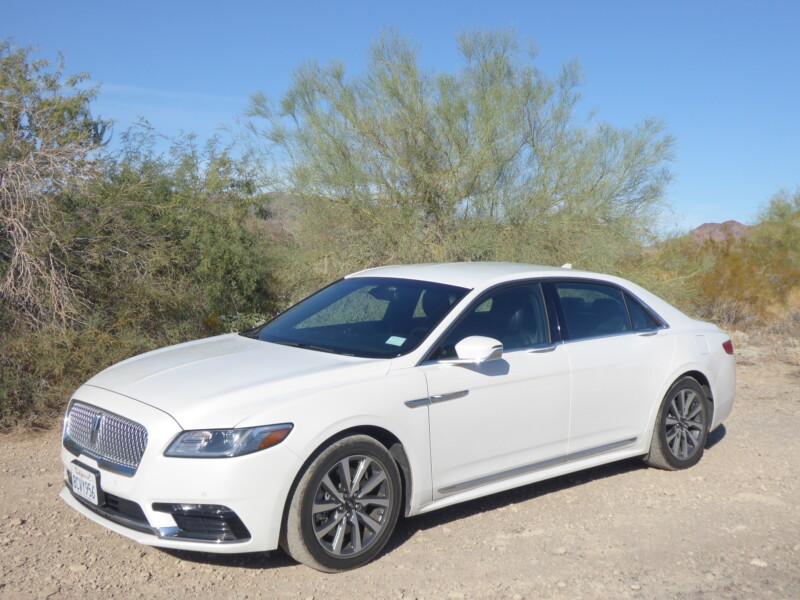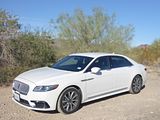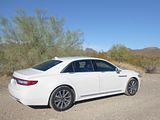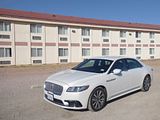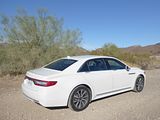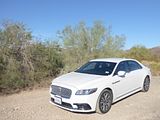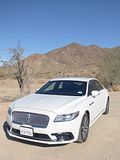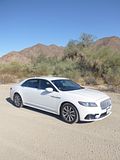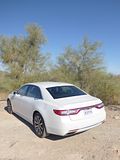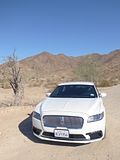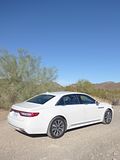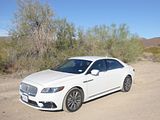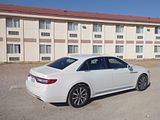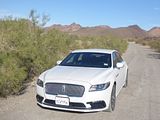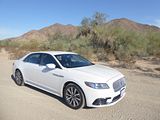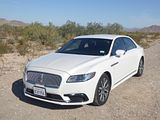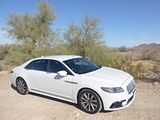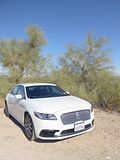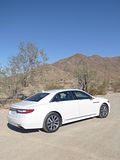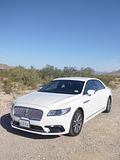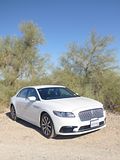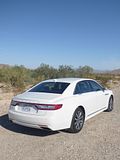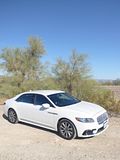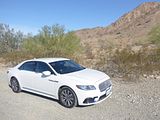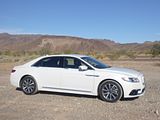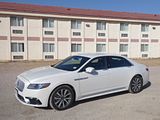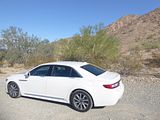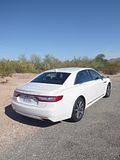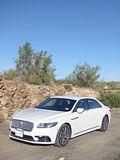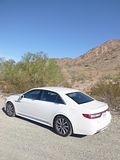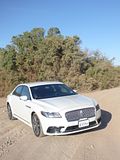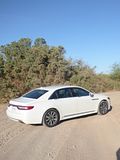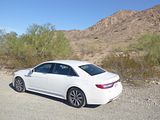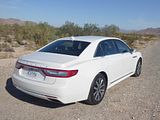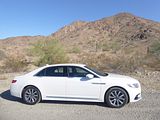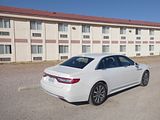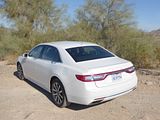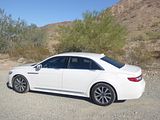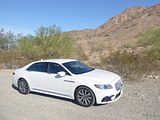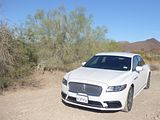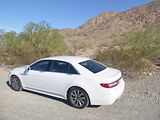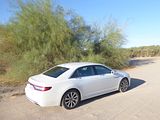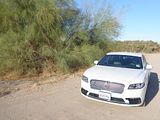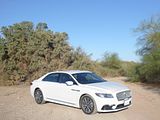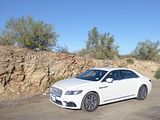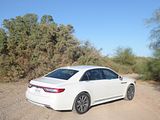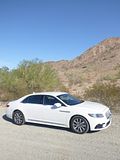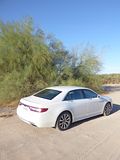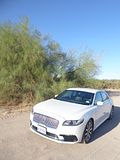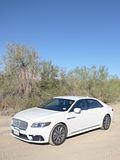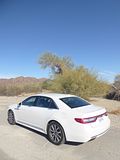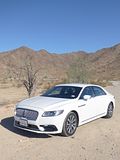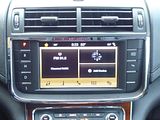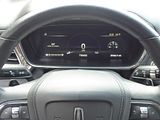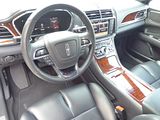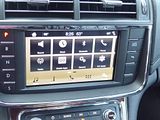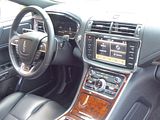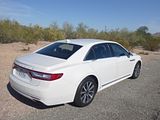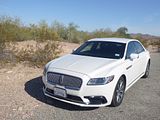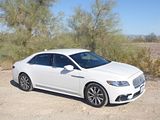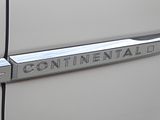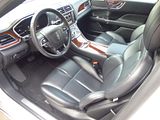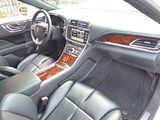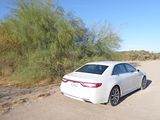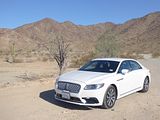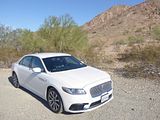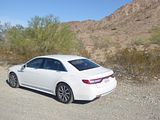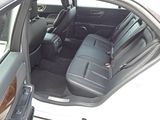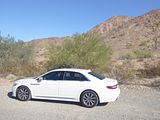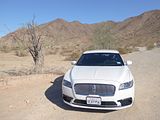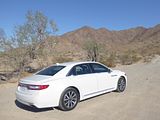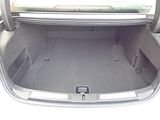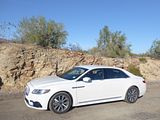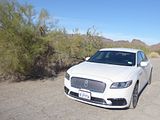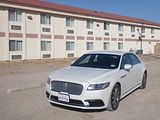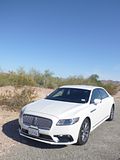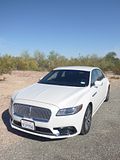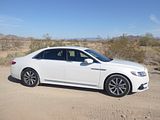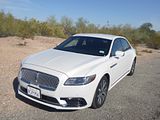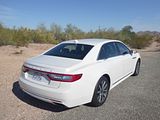Lincoln has a long history of producing prestige cars and it did not take long before the brand had established a reputation for producing luxury models which competed strongly with Cadillac. Both companies were very focused on the US domestic market, which, of course, has always been sizeable, but by the late 30s, there were signs of growing competition from European brands that were starting to become a little more available in the New World, so Lincoln decided to try to build something that they though was a little more European in flavour. The result was a car that they called the Continental. The model line was introduced following the construction of a personal vehicle for Edsel Ford, who commissioned a coachbuilt 1939 Lincoln-Zephyr convertible, developed as a vacation vehicle to attract potential Lincoln buyers. In what would give the model line its name, the exterior was given European “continental” styling elements, including a rear-mounted spare wheel. That first-generation Continental of 1940 was the progenitor of an entirely new automotive segment, the personal luxury car. Following World War II, the segment evolved into coupes and convertibles larger than sports cars and grand touring cars with an emphasis on features, styling, and comfort over performance and handling. From 1956 to 1957, the Continental nameplate was the namesake of the short-lived Continental Division, marketing the 1956–1957 Continental Mark II as the worldwide flagship of Ford Motor Company. It did not sell in large numbers, with fewer than 3000 built and it is believed that Ford lost a lot of money on each one sold, but the third generation 1961 car, priced 40% lower than its predecessor thanks to abandoning the hand-built nature of the car, found far greater favour. Ford continued to evolve the name which led to the introduction of the Continental Mark series in 1969, which was the produced over six generations to 1998. Along with the creation of the personal luxury car segment, the Lincoln Continental marked the zenith of several designs in American automotive history. The Continental is the final American vehicle line with a factory-produced V12 engine (1948), the final four-door convertible (1967), and the final model line to undergo downsizing (for the 1980 model year). By the late 1980s, the luxury segment in which the Continental competed had changed drastically from a decade before. In addition to traditional competitors Cadillac and Chrysler, the Continental now competed against Mercedes-Benz, BMW, and Audi and eventually the top-of-the-line vehicles of Acura, Lexus, and Infiniti. In anticipation Lincoln had chosen to completely reinvent the Continental, starting with the development of eighth generation model in the 4th quarter of 1981. Sales continued to decline though, and Lincoln faced a significant model overlap as the Continental, LS V8, and Town Car competed in nearly the same price range. As the LS V8 was a mid-size sport luxury sedan and the Town Car was a full-size luxury sedan, the Continental was withdrawn, with the final ninth-generation vehicle rolling off the Wixom Assembly production line on July 26, 2002, with no successor. For 2009, Lincoln introduced the MKS, which was intended to replace the Town Car, though this behemoth, popular in the livery rental market remained until 2011. The MKS was closer in length and width to the ninth-generation Continental and based on a front-wheel drive chassis (with all-wheel drive as an option). In place of a V8 engine, the MKS offered a twin-turbocharged V6 as an option. The MKS was never a strong seller. When it came to a replacement, Lincoln showed a concept version in 2015 and followed this up with a production car at the 2016 New York Show, choosing to dust off the Continental name for a tenth generation of the car to be so called.
The tenth-generation Lincoln Continental is based upon the Ford CD4 platform. Shared with the Ford Fusion (Mondeo) and Lincoln MKZ, the Continental shares an extended-wheelbase CD4 chassis with the seventh-generation Ford Taurus. At 117.9 inches (5.7 inches longer than the Fusion/MKZ), the Continental is the longest-wheelbase Lincoln sedan produced since 1979 with the exception of the long wheelbase L Town Cars. While front-wheel drive is standard, this generation marks the first use of all-wheel drive on a Lincoln Continental, but depending on trim, all-wheel drive is either optional or standard equipment. Lincoln aimed the car directly at the Cadillac XTS which had followed a similar sort of approach, sharing underpinnings with smaller family members and using front wheel drive as standard. It has other rivals, too, with the Buick Lacrosse, Toyota Avalon and Kia Cadenza offering more features for the same sort of money as the cheaper Continental models, and those with prestige badges from Germany or Genesis, competing with the top models in the Continental range. I’ve been keen to try a Continental ever since I first saw it at the 2016 Los Angeles Auto Show. But just as its immediate predecessor, the MKS and the related MKT had eluded me for years, with no Lincoln cars apart from the gargantuan Navigator in the Hertz fleet, I feared that the chance was never going to come. Intriguingly, when Hertz revised their fleet description on their website for 2018, they switched to citing the Continental as the sample car for their Group I Luxury Car, so I thought my luck might finally be in, but despite looking on every visit in 2018, I still saw no examples of the model parked up. And the same seemed to be true in 2019, but finally, on my third and final visit of the year, I spotted a couple parked up and moved quickly to try to secure one. I succeeded and hence am finally able to present my conclusions on the car a couple of years after its launch with this 2018 test car.
bThe test car came from the bottom of the range, and that actually means the largest of the three available engines. It’s a 3.7 litre V6 unit, related to the one seen until recently in the V6 Mustang among other cars, and it generates 305 bhp, which is a little less than you will find in some of the Continental’s rivals. There is keyless starting and when you press the button and set off, there is quite a throaty roar, which I found rather appealing. The Continental goes well, with strong acceleration available throughout the rev range and no matter which of the 6 gears the car is in. The only available transmission is a 6 speed automatic and the gear selection is done with buttons on he done, to the left of the infotainment screen. There are column-mounted paddles as well should you prefer to change the hears yourself. I found that it could be caught out, but was generally responsive in operation. More to the point, perhaps was the fact that engine noise was well suppressed and this Lincoln was a very refined and quiet car at a steady speed on the freeway, which is where I covered most of my test miles. They amounted to a heady 535 miles in the day of my tenure and the car needed 19.1 gallons to ensure I could return it full. This computes to 28.0 mpg US or 33.46 mpg Imperial, which is a very respectable figure for a large luxury car.
Those who think that since this is a product of the Ford Motor Company, and so it is likely to be as good to drive as their other products could be in for a bit of a disappointment. It’s not bad, indeed far from it, but it lacks the precision that you get in a Fiesta or a Fusion. There is a clever variable ratio system but in practice the steering is light and does not have a huge amount of feel, though it is leagues better than the last large Lincoln I tested, some years ago. In the front wheel drive guise of the test car, it handles well enough, but the emphasis here is more on luxury and comfort than fun, so you won’t be looking for the twisty route home and if you do tackle the bends with some gusto, you won’t feel that this Lincoln rewards like some of the smaller products with Ford family badges on them. The ride is equally unremarkable. It is neither unduly soft, as old school Lincoln cars used to be not anything like as firm as the German exec barges are. This version of the Continental came on 18” wheels. I found the brakes could be a bit grabby but they were certainly effective in bringing the car to a halt without needing undue pressure on the pedal. There is an electronic handbrake button on the dash. On the move visibility is a bit of a mixed bag, as the door mirrors are very small, but they do feature the simple but effective solution of having two pieces of glass to give a solution to the blind spot problem. Rear parking sensors and the camera do make reversing the car a lot easier than it otherwise would be.
Lincoln position the Continental as a luxury car so even in the entry level trim of this one, there is a lot of leather used in the cabin. Sadly not all of it is the softest, so the impression of true quality is a bit challenged in some respects, the feel of the steering wheel being the most obvious example of this. The dash does also feature “wood” inlays and chrome highlights. Overall it is a neat enough design, and it is at least as good, if not better than you will find in a Cadillac but the European and Asian rivals all do it better. There are a collection of digital dials grouped together in a single cluster, though the overall effect is a little odd. There is a central digital speedometer and to the left a bar chart style fuel gauge with a compass showing to the right, and that is it. Like most cars these days, the Continental features twin column stalks for indicators and wipers, and these are very chunky items which differ from those you will find in cheaper Ford products, with lights operated by a rotary dial on the dash to the left of the wheel. The steering wheel hub contains audio repeated and cruise controls. The centre of the dash is dominated by the infotainment touch screen. You don’t get navigation on the Premiere trim but there is XM satellite radio, as well as Apple Car Play and Android Auto, all presented through the Ford Sync 3 system. There are some buttons and knobs beneath the unit, so operating it all was quite straight-forward and the system seemed quite responsive. The audio system has 10 speakers and the sound quality was good. Below this unit are a large collection of buttons for the dual zone climate control.
There are touch-pad door releases, and posher trim versions also get an electric door closing using a system that Lincoln called E-Latch. Continuing a long-held tradition of more luxurious Ford Motor Company cars, there is also keyless entry with a keypad on the door pillar. Seat trim in the entry level Premiere version of the test car is a sort of synthetic leather, though again, the quality is not really commensurate with the car’s luxury aspirations. Seat adjustment – moving in 10 ways, apparently – is all electric, with the switches to move the seat around being found on the door. The seat powers back when the ignition is off and you open the door easing access, not that this is a challenge anyway. Seat heaters are included even in the entry level trim. The seats are large and appear a bit shapeless, but I found them comfortable having spent many hours sitting on them on the one day that I had the car.
The Continental is a large car and that manifests itself when you open the rear doors and see just how much space there is there. Even though the centre console comes quite a way back, leg, shoulder and headroom are all on the generous side and occupants here should easily be able to get comfortable, taking advantage also of the drop-down central armrest which includes a cubby area. There are also door bins and map pockets for other odds and ends.
The boot is also large, being both wide and long from front to back, though it is not as high as you might expect. You can create an even longer load platform by dropping down the asymmetrically split rear seat backrests. There is a space saver wheel under the boot floor and you could tuck a few bits and pieces around this. Inside the cabin, there are plenty of places for odds and ends, though with the exception of the wide and deep central armrest cubby, none of them which include a modestly sized glovebox, lidded cupholders in the console and pockets on the doors are that large.
Three engines are available for the Continental. The base engine is a 3.7-litre V6 (305 bhp, 280 lb/ft of torque), which comes standard on the Premiere and Select trims. A turbocharged 2.7-litre V6 (335 bhp, 380 lb/ft of torque) is optional on the Select and standard on the Reserve and Black Label Trims. Both engines are paired with a six-speed automatic transmission and can be had in either front-wheel-drive or all-wheel-drive configurations. The third engine option is a turbocharged 3.0-litre V6 (400 bhp, 400 lb/ft of torque) that’s optional on the Reserve and Black Label trims. To manage this engine’s power, Lincoln bundles it with a torque-vectoring AWD system. This engine also uses a six-speed automatic transmission. Beyond the 3.7-litre V6, the Premiere trim receives 18-inch alloy wheels, LED daytime running lights and taillights, power-folding side mirrors (driver-side auto dimming), front and rear parking sensors, a rearview camera, automatic headlights, hill-start assist, adaptive suspension and steering, and keyless entry. Inside, you get dual-zone climate control with a rear-seat air vents, heated 10-way power-adjustable driver and passenger seats, simulated leather upholstery, a 60/40-split folding rear bench and push-button start. Infotainment duties are handled by Ford’s Sync 3 system, which comes with an 8-inch touchscreen interface, Apple CarPlay and Android Auto integration, satellite radio, two USB ports, and a 10-speaker sound system. The base Premiere also comes with Lincoln Connect, which allows you to use an app to remotely start the car, lock and unlock it, or locate it via GPS, among other features. Moving up to the Select trim adds 19-inch wheels, power-operated soft-close doors, a hands-free boot lid opener, leather upholstery and rear-seat USB ports. Beyond the engine choices, several options packages are available. The Climate Package adds automatic high beams, automatic wipers, a windshield-wiper de-icer, an auto-dimming rearview mirror, heated rear seats and a heated steering wheel. The Technology package includes the auto wipers, windshield wiper de-icer and auto-dimming rearview mirror, as well as a head-up display and a suite of driver aids: a top-down parking camera system, adaptive cruise control, lane departure warning and intervention, and forward-collision warning with automatic emergency braking. Blind-spot monitoring is a stand-alone option. Other options include navigation, a 13-speaker Revel stereo, Lincoln’s 30-way power-adjustable “Perfect Position” seats, 20-inch wheels and a panoramic sunroof. The Continental’s Reserve trim, on top of starting with the turbocharged 2.7-liter V6, gets blind-spot monitoring, the 13-speaker Revel stereo and navigation standard. It also upgrades to 24-way power-adjustable front seats that are heated and ventilated, three-zone automatic climate control with separate rear-seat controls, and a power rear-window sunshade. The Climate and Technology packages are available for the Reserve, as are two more major packages. The Rear Seat package adds upgraded outboard rear seating (four-way power lumbar, reclining, heating and ventilation), rear side-window sunshades and the panoramic sunroof. The Luxury package adds LED headlights, upgrades the stereo to Revel’s 19-speaker system and adds a CD player. The sunroof, 30-way power-adjustable front seats and 20-inch wheels are available as stand-alone options. At the top of the range, and nearly doubling the Premiere’s starting price, is the Continental Black Label. This trim comes standard with 20-inch wheels, the panoramic moonroof and both the Luxury and Technology packages. It also benefits from unique interior trims that combine bold colours and trims with lots of extra premium materials draped over many of the interior plastics. The 30-way seats and Technology and Climate packages are available as upgrades. Buying a Black Label car also gets the buyer access to Lincoln’s lifestyle and concierge service. Lincoln will wash your car for free, pick it up from you for service and book you reservations (and even buy you a dinner), among other services. Black Label Continentals are also covered by a four-year/50,000-mile that covers services and wear items.
I actually quite liked this Continental. The neat and slightly unassuming looks appeal far more than any Cadillac and the car was decent enough to drive. Sadly, it would seem that even if people agree with me, they don’t then go on to buy one, preferring to go with a crossover-type vehicle and so Lincoln have announced that production of the car will cease in 2020, with no direct replacement being planned. Apparently, there are quite a few in the Hertz fleet, but they tend to get snapped up as soon as someone brings one back to the facility, so I was clearly quite lucky to have sourced this one. Although it is not that likely, if I did end up getting another one, I’d not be unhappy.

